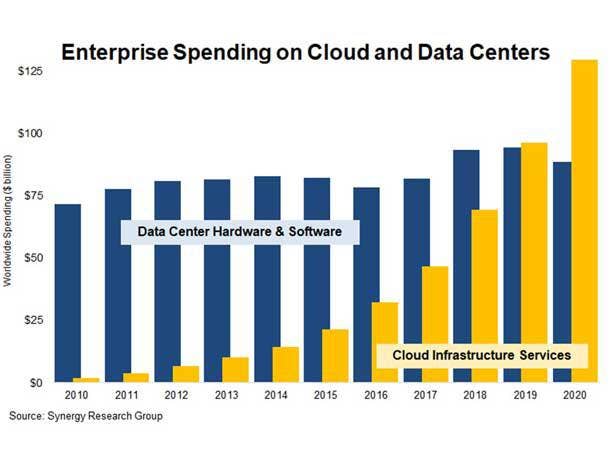Cloud Services Reach $130B, Dwarfs Data Center Spending
“It took ten years for enterprise spending on cloud services to catch up with enterprise spending on data center hardware and software, then in 2020 the market for cloud services again soared, while spending on owned data centers dropped by 6 percent,” said Synergy Research Group Chief Analyst John Dinsdale.

Enterprises spent a whopping $130 billion on cloud infrastructure services globally in 2020, blowing by the $90 billion enterprises spent on data center products at an unprecedented rate.
While 2020 can be viewed as something of an anomaly due to the COVID-19 pandemic, the trends are “absolutely clear,” according to John Dinsdale, a chief analyst at Synergy Research Group.
“It took ten years for enterprise spending on cloud services to catch up with enterprise spending on data center hardware and software, then in 2020 the market for cloud services again soared, while spending on owned data centers dropped by 6 percent,” said Dinsdale. “In the last ten years, CIOs and business managers have increasingly voted with their wallets and decided that cloud services are the way to go. … And we expect [that] to continue for many years to come.”
Enterprise spending on cloud infrastructure services reached nearly $130 billion in 2020, representing an increase of 35 percent annually, according to new data from Synergy Research Group. Enterprise spending on data center hardware and software fell 6 percent year over year to $89 billion.
[Related: Microsoft To Build New $200M Data Center As Azure Sales Soar]
In 2019, the two market segments of cloud infrastructure services and data center hardware and software were almost equal in size at roughly $95 billion each. However, the global COVID-19 pandemic -- which forced millions of people to work remotely -- fueled a major shift in worldwide IT operations and spending towards the cloud.
Over the past decade, average annual spending growth for data center hardware and software – which includes servers, storage, networking, security and associated software -- was just 2 percent. Comparatively, over the last ten years, average annual spending growth for cloud services – such as Infrastructure as-a-Service, Platform as-a-Service and hosted private cloud - was 52 percent.
One key finding in Synergy Research Group’s report is that approximately 60 percent of servers currently being sold are going into cloud provider’s data centers and not those owned and operated by enterprises.
The three largest public cloud vendors have effectively taken over market share of hyperscale data centers, which represent many of the new, massive data centers currently being built around the world. Amazon, Microsoft and Google collectively now account for more than 50 percent of the world’s largest data centers as the three companies spend billions each year on building and expanding their global data center footprint to accommodate the high demand for cloud services. Amazon and Google opened more new data centers in 2020 than any other company, accounting for half of the total number of new hyperscale data centers opened last year, according to Synergy.
The largest colocation data center providers in the world have adjusted their offerings and go-to-market strategy to accommodate these hyperscale cloud players.
For example, Equinix is pouring $3 billion into building custom data centers across the globe to win over wallet share from the likes of AWS, Google and Microsoft, who are all Equinix customers. Equinix is spending billions on its xScale data center program, which is a new type of data center specifically built to support the rising demands of cloud services providers that need to scale rapidly.
Overall, Synergy’s Dinsdale said enterprises are choosing to invest in cloud services provided by a public cloud provider rather than spending on their own data center infrastructure when needing computing power to manage data and run business applications.
“Clearly companies have been voting with their wallets on what makes the most sense for them,” said Dinsdale. “We do not expect to see such a drastic reduction in spending on enterprise data centers over the next five years, but for sure we will continue to see aggressive cloud growth over that period.”